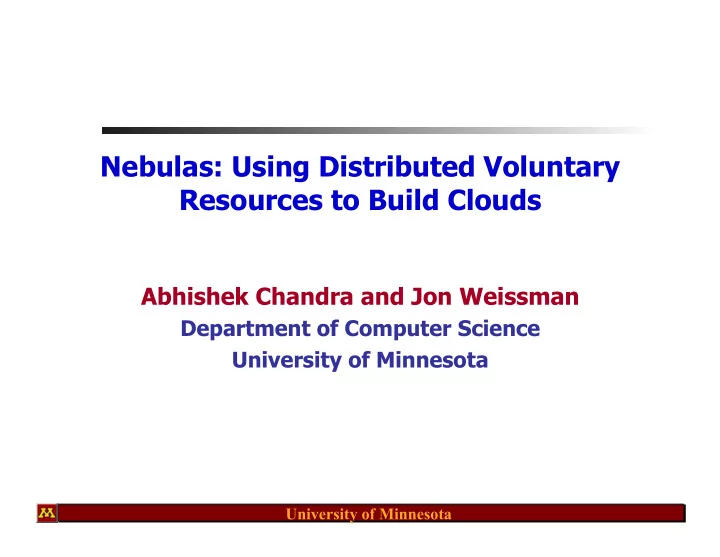

Nebulas: Using Distributed Voluntary Resources to Build Clouds Abhishek Chandra and Jon Weissman Department of Computer Science University of Minnesota University of Minnesota
Clouds Cloud: Hides details of actual service deployment from users Users University of Minnesota
Current Cloud Model Cloud: Hides details of actual service deployment from users Users University of Minnesota
Current Cloud Model Largely centralized (or small degree of distribution) Pay-as-you-go model Strong guarantees Question: Are there services that do not need/ fit this cloud model? University of Minnesota
Class 1: “Experimental” Services Experimental deployment for: Debugging, viability, requirement estimation University of Minnesota
Class 1: “Experimental” Services Experimental deployment for: Debugging, viability, requirement estimation USENIX 09 SOSP 07 OSDI 08 SOSP 2009 University of Minnesota
Class 2: Dispersed-Data-Intensive Services Data is geographically distributed Costly, inefficient to move to central location University of Minnesota
Class 2: Dispersed-Data-Intensive Services Data is geographically distributed Costly, inefficient to move to central location blog1 blog2 blog3 University of Minnesota
Class 3: Shared “Public” Services Personal application offered as free service User-demand driven, scale-up/scale-down needed Tour of Paris University of Minnesota
Class 3: Shared “Public” Services Personal application offered as free service User-demand driven, scale-up/scale-down needed Tour of Paris University of Minnesota
Common Service Characteristics Elastic resource consumption Scale up/down based on demand Geographical data/user distribution Execution dependent on location of data/user Low/no cost Do not want to pay for resources Weak performance/robustness requirements Some failures may be ok University of Minnesota
Cloud Cloud: Hides details of actual service deployment from users Users University of Minnesota
Nebula Decentralized, less-managed cloud Dispersed storage/compute resources No/low user cost Users University of Minnesota
Building Nebulas Idea: Use distributed voluntary resources Resources donated by end-users ala @home, P2P systems University of Minnesota
Why Voluntary Resources? Scalability: Large number of resources available SETI@Home: Over 2.2 million computers contributing ~510 TFlops of compute power Kazaa: Over 3.5 million users Low cost: Minimal deployment, management costs [Kondo09]: 2 orders of magnitude difference in EC2 vs. SETI@home resources/$ Dispersion: Geographically distributed Users can be located worldwide University of Minnesota
How is Nebula different from @home? Cloud-oriented services impose new requirements Requirement Nebula @home Collective High None performance Locality/Context- High Low awareness Statefulness High/medium Low University of Minnesota
Challenges Heterogeneity Different nodes have different CPU speeds, network bandwidth, loads Resource dispersion Data sources and compute resources may be widely distributed Unreliability Node/link failures, high churn University of Minnesota 17
Handling Heterogeneity Heterogeneity-aware resource selection and allocation Allows better collective performance Trivedi et al. [IJHPCA06]: Fit tasks to node capability Heterogeneity-aware allocation reduces execution time University of Minnesota
Handling Data Dependence Find compute nodes and data sources with high accessibility to each other Kim et al. [UM-TR08]: Use passive accessibility estimation Data accessibility-based selection improves download time University of Minnesota
Handling Failures Replication, state-maintenance Sonnek et al. [TPDS07]: Reliability-aware dynamic replication Dynamic replication improves performance, reliability University of Minnesota 20
Other Issues/Challenges Incentivizing Nebulas Market economy, bartering, auctions How to prevent cheating/freeloading? Deployment tools/APIs/client support Virtualization, Middleware? Privacy/security issues How to secure systems and applications? We think: Nebulas not suitable for privacy- sensitive services University of Minnesota
Summary Current Cloud models: Well-provisioned, well-managed, centralized Some service classes: Need loose performance, low/no cost, distributed data-intensive Nebula: Distributed, less-managed clouds Use voluntary resources University of Minnesota
Recommend
More recommend